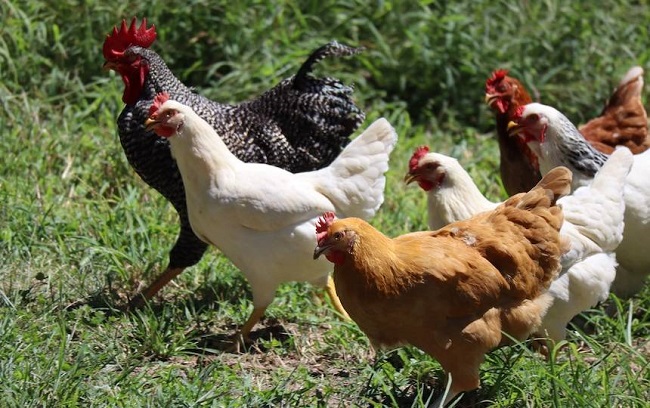Raising chickens for meat is a practice as old as domestication itself. Meat chicken breeds, or broilers, are specifically raised and bred for their size and the quality of their meat.
This guide will take you on a journey through some of the most popular meat chicken breeds, offering insights into their growth rates, characteristics, and the quality of meat they provide.

Discovering Meat Chicken Breeds
Here are some meat chicken breeds:
Read Also:
Cornish Cross
The Cornish Cross is one of the most popular meat chicken breeds. Known for its quick growth and substantial meat production, it’s a staple in commercial poultry farming. These birds typically reach slaughter weight (4-5 pounds) in just 4 to 6 weeks.
Jersey Giant
As the name suggests, the Jersey Giant is a large breed that can reach up to 13 pounds. Despite their size, they are known for their docile nature. These birds grow slower than the Cornish Cross, typically ready for slaughter around 16-21 weeks, but offer a generous amount of meat.
Freedom Ranger
Freedom Rangers, also known as Red Rangers, are a great choice for free-range farming due to their active foraging behavior. These birds offer a good balance of size and taste, with a more complex flavor profile compared to some other meat breeds.
Bresse
Originating from France, Bresse chickens are often considered the finest-tasting chicken in the world. While not as large as some other meat breeds, their meat quality and taste are unparalleled, which often commands a higher price.
Nutrition and Meat Quality of Different Breeds
Meat from different chicken breeds can vary in taste, texture, and nutritional content. Factors influencing these differences include the breed’s genetics, diet, and lifestyle.
For instance, Bresse chickens, known for their gourmet meat, are raised under strict regulations in France that include specific diet and free-range requirements.
Raising Meat Chicken Breeds: Tips and Considerations
While raising meat chickens can be a rewarding endeavor, it requires careful planning and management. This includes providing ample space, maintaining hygiene, ensuring a balanced diet, and keeping a close eye on their health.
It’s also important to consider the growth rate of your chosen breed. Faster-growing breeds like the Cornish Cross may be more efficient if quick meat production is your goal, while slower-growing breeds like the Jersey Giant or Bresse may be preferred for their size or meat quality.
Breeding Meat Chicken Breeds: An Important Consideration
Breeding your meat chickens can be a rewarding part of poultry farming. However, it’s important to remember that most commercial meat breeds, like the Cornish Cross, are hybrid birds.
This means they do not breed true; the offspring will not necessarily have the same characteristics as the parents.
For breeds like the Jersey Giant, Freedom Ranger, and Bresse, which are standard (non-hybrid) breeds, you can expect the offspring to carry similar traits to their parents.
Broiler Housing and Environment: Key to Healthy Growth
Proper housing is crucial for raising meat chickens. A well-designed chicken coop provides protection from predators and weather, reduces the spread of disease, and allows chickens access to clean water and food.
Meat chickens, particularly fast-growing breeds, also require plenty of space to prevent overcrowding and promote healthy growth.
Consideration must also be given to temperature control. Chicks require a warm environment, typically around 95 degrees Fahrenheit during their first week, decreasing by about 5 degrees each week until they are fully feathered.
Feed and Nutrition: Building Blocks of Quality Meat
To raise healthy meat chickens, a nutritionally balanced diet is key. Chicken feed usually contains a mix of grains, protein (from soybean or canola meal), and a small amount of vitamins and minerals.
Fast-growing meat chicken breeds have been bred to convert feed into muscle quickly and efficiently, so providing them with high-quality feed is crucial.
In some cases, farmers may choose to feed their chickens organic or non-GMO feed, or raise them on pasture for a portion of their diet. This not only impacts the health and welfare of the birds, but it can also affect the taste and nutritional profile of the meat.
Ethics of Raising Meat Chickens
As with any form of livestock production, ethical considerations are critical when raising meat chickens. This involves providing a life that allows for natural behaviors, such as scratching and pecking, minimizing stress, and ensuring a humane end of life.
Different breeds can vary greatly in their welfare needs and potential health issues, so it’s important to choose a breed that suits your ability to provide care.
Ultimately, understanding and respecting the needs of your chosen meat chicken breed can lead to healthier birds, higher-quality meat, and a more rewarding chicken-raising experience.
Key Takeaways
- Meat chicken breeds are raised specifically for their size and the quality of their meat.
- The Cornish Cross, Jersey Giant, Freedom Ranger, and Bresse are popular meat chicken breeds.
- The choice of breed depends on various factors including growth rate, meat quality, and rearing conditions.
Understanding meat chicken breeds not only helps in making informed decisions about poultry farming but also provides a deeper appreciation of this age-old practice.
The right knowledge and management can ensure a healthy, productive flock, and high-quality meat to fill your table.
Read Also:
Conclusion
Exploring meat chicken breeds reveals a diverse world, each breed with its unique traits and benefits. Whether it’s the fast-growing Cornish Cross, the large Jersey Giant, the active Freedom Ranger, or the gourmet Bresse, your choice will depend on your specific needs and preferences.
























